Organizational Analysis Assessment 1: Detailed Student Analysis Report
VerifiedAdded on 2022/10/19
|7
|2494
|455
Homework Assignment
AI Summary
This assignment is a student's response to Organizational Analysis Assessment 1, focusing on critically analyzing four readings and reconciling them with the four perspectives discussed in lectures and the Hirschheim and Klein (1989) paper. The student deconstructs the arguments presented by the authors in each reading, examining their methods of convincing readers, and establishing relationships between these elements. The analysis covers topics such as the integration of ICT in education, new learning languages, digital technology in teaching, and the development of information systems, all within the context of organizational analysis and the quest for legitimate knowledge. The student demonstrates an understanding of how knowledge is legitimized, providing a comprehensive overview of the readings' core arguments and methodologies.

Organizational Analysis Assessment
1
Student Name
Student ID
1
Student Name
Student ID
Paraphrase This Document
Need a fresh take? Get an instant paraphrase of this document with our AI Paraphraser

Organizational Analysis Assessment
1
Question Four rationales of organizational analysis
1.Argument
presented by the
author
The author explains how ICT is the ultimate tool that solves the issue of teachers
meeting the needs of the students individually. Therefore, the innovations in IT and its
development can rationalize the tools resulting in flexible and effective learning.
The new language in learning has a connection with the inclination of the present
society. Haugsbakk, &Nordkvelle (2007), provide that education is currently a
commodity, and learners require a delivery that equates the amounts paid to acquire the
services from the teacher. Moreover, the author provides that ICT is more useful in
improving learning and teaching.
Most organizations have integrated aspects of advanced technology aimed at protecting
their information systems. The reason for protecting the information system is because
they are considered as the identity of a business or organization and their replacements
are hardly found. The tools used for safeguarding information systems are used for
managing and maintaining user identities, limiting unauthorized access to the system
and data, and ensuring the quality and availability of software and system. Thus, it is
essential to protect the information system from unauthorized access, damage, and
disclosure.
2. Method of
convincing readers
The data is obtained from other journals, colleges, and articles that have analysed the
effectiveness of the new language.
For instance, the Classfronter enhances freedom and simplicity in learning at
universities in Norway. Hence, the new language promotes distance learning.
The graphs provided in the article indicate that students can access tuition easily. Thus
the interaction provides an opportunity for the instructor to share ideas that a leaner is
allowed to dispute if incorrect. Moreover, the rhetoric of ICT enables access to pre-
produced education materials within the curriculum.
Relationship
between1&2above
Adopting the new language assist in enhancing education standards. Therefore,
students can research from the internet for answers from the teachers because they are
not restricted to specific leaning materials. Educators interact with students over the
sessions because ideas get shared and both parties benefit from the information. The
changes have to be addressed to ensure the rhetoric of ICT gets understood by
institutions and students. Many people all over the world have asked questions as to if
the languages used influence the way people think or are just an expression of their
thoughts. It may be confusing to answer this question, but most individuals think that it
is a yes. People tend in a certain manner to talk, believe or even act because they have
come from a certain location. Further facts show that the ideas and culture of people
are determined by the language they talk are found by the scientists. Some languages
use certain terms and ideas, while others refer to certain ideas by certain phrases.
Question Four rationales of organizational analysis
1.The argument presented
by the author
According to Biesta (2005), the new language in learning acknowledges
education as an economic interaction between educators and students.
Therefore, educators have to meet the expectations of learners by providing
quality services.
1
Question Four rationales of organizational analysis
1.Argument
presented by the
author
The author explains how ICT is the ultimate tool that solves the issue of teachers
meeting the needs of the students individually. Therefore, the innovations in IT and its
development can rationalize the tools resulting in flexible and effective learning.
The new language in learning has a connection with the inclination of the present
society. Haugsbakk, &Nordkvelle (2007), provide that education is currently a
commodity, and learners require a delivery that equates the amounts paid to acquire the
services from the teacher. Moreover, the author provides that ICT is more useful in
improving learning and teaching.
Most organizations have integrated aspects of advanced technology aimed at protecting
their information systems. The reason for protecting the information system is because
they are considered as the identity of a business or organization and their replacements
are hardly found. The tools used for safeguarding information systems are used for
managing and maintaining user identities, limiting unauthorized access to the system
and data, and ensuring the quality and availability of software and system. Thus, it is
essential to protect the information system from unauthorized access, damage, and
disclosure.
2. Method of
convincing readers
The data is obtained from other journals, colleges, and articles that have analysed the
effectiveness of the new language.
For instance, the Classfronter enhances freedom and simplicity in learning at
universities in Norway. Hence, the new language promotes distance learning.
The graphs provided in the article indicate that students can access tuition easily. Thus
the interaction provides an opportunity for the instructor to share ideas that a leaner is
allowed to dispute if incorrect. Moreover, the rhetoric of ICT enables access to pre-
produced education materials within the curriculum.
Relationship
between1&2above
Adopting the new language assist in enhancing education standards. Therefore,
students can research from the internet for answers from the teachers because they are
not restricted to specific leaning materials. Educators interact with students over the
sessions because ideas get shared and both parties benefit from the information. The
changes have to be addressed to ensure the rhetoric of ICT gets understood by
institutions and students. Many people all over the world have asked questions as to if
the languages used influence the way people think or are just an expression of their
thoughts. It may be confusing to answer this question, but most individuals think that it
is a yes. People tend in a certain manner to talk, believe or even act because they have
come from a certain location. Further facts show that the ideas and culture of people
are determined by the language they talk are found by the scientists. Some languages
use certain terms and ideas, while others refer to certain ideas by certain phrases.
Question Four rationales of organizational analysis
1.The argument presented
by the author
According to Biesta (2005), the new language in learning acknowledges
education as an economic interaction between educators and students.
Therefore, educators have to meet the expectations of learners by providing
quality services.
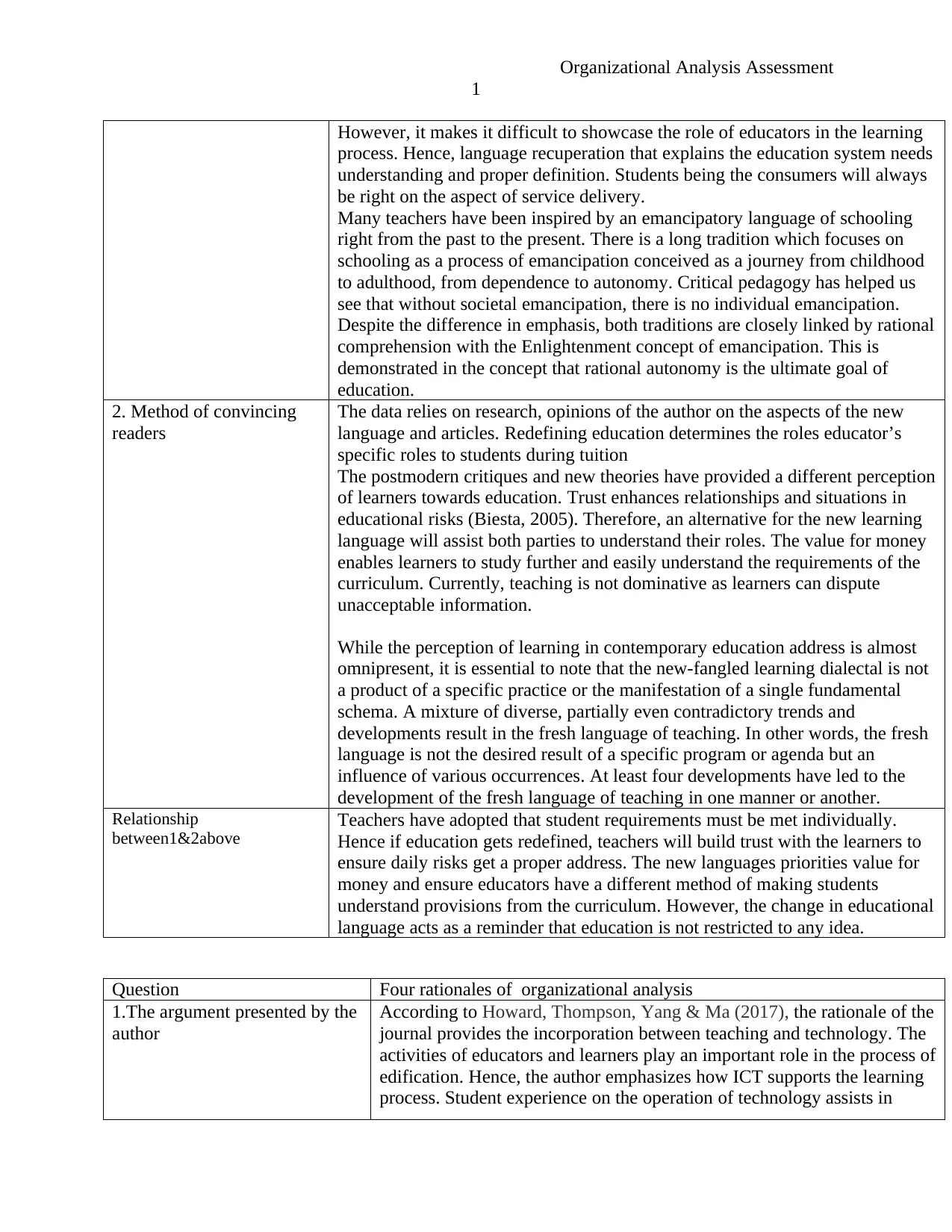
Organizational Analysis Assessment
1
However, it makes it difficult to showcase the role of educators in the learning
process. Hence, language recuperation that explains the education system needs
understanding and proper definition. Students being the consumers will always
be right on the aspect of service delivery.
Many teachers have been inspired by an emancipatory language of schooling
right from the past to the present. There is a long tradition which focuses on
schooling as a process of emancipation conceived as a journey from childhood
to adulthood, from dependence to autonomy. Critical pedagogy has helped us
see that without societal emancipation, there is no individual emancipation.
Despite the difference in emphasis, both traditions are closely linked by rational
comprehension with the Enlightenment concept of emancipation. This is
demonstrated in the concept that rational autonomy is the ultimate goal of
education.
2. Method of convincing
readers
The data relies on research, opinions of the author on the aspects of the new
language and articles. Redefining education determines the roles educator’s
specific roles to students during tuition
The postmodern critiques and new theories have provided a different perception
of learners towards education. Trust enhances relationships and situations in
educational risks (Biesta, 2005). Therefore, an alternative for the new learning
language will assist both parties to understand their roles. The value for money
enables learners to study further and easily understand the requirements of the
curriculum. Currently, teaching is not dominative as learners can dispute
unacceptable information.
While the perception of learning in contemporary education address is almost
omnipresent, it is essential to note that the new-fangled learning dialectal is not
a product of a specific practice or the manifestation of a single fundamental
schema. A mixture of diverse, partially even contradictory trends and
developments result in the fresh language of teaching. In other words, the fresh
language is not the desired result of a specific program or agenda but an
influence of various occurrences. At least four developments have led to the
development of the fresh language of teaching in one manner or another.
Relationship
between1&2above
Teachers have adopted that student requirements must be met individually.
Hence if education gets redefined, teachers will build trust with the learners to
ensure daily risks get a proper address. The new languages priorities value for
money and ensure educators have a different method of making students
understand provisions from the curriculum. However, the change in educational
language acts as a reminder that education is not restricted to any idea.
Question Four rationales of organizational analysis
1.The argument presented by the
author
According to Howard, Thompson, Yang & Ma (2017), the rationale of the
journal provides the incorporation between teaching and technology. The
activities of educators and learners play an important role in the process of
edification. Hence, the author emphasizes how ICT supports the learning
process. Student experience on the operation of technology assists in
1
However, it makes it difficult to showcase the role of educators in the learning
process. Hence, language recuperation that explains the education system needs
understanding and proper definition. Students being the consumers will always
be right on the aspect of service delivery.
Many teachers have been inspired by an emancipatory language of schooling
right from the past to the present. There is a long tradition which focuses on
schooling as a process of emancipation conceived as a journey from childhood
to adulthood, from dependence to autonomy. Critical pedagogy has helped us
see that without societal emancipation, there is no individual emancipation.
Despite the difference in emphasis, both traditions are closely linked by rational
comprehension with the Enlightenment concept of emancipation. This is
demonstrated in the concept that rational autonomy is the ultimate goal of
education.
2. Method of convincing
readers
The data relies on research, opinions of the author on the aspects of the new
language and articles. Redefining education determines the roles educator’s
specific roles to students during tuition
The postmodern critiques and new theories have provided a different perception
of learners towards education. Trust enhances relationships and situations in
educational risks (Biesta, 2005). Therefore, an alternative for the new learning
language will assist both parties to understand their roles. The value for money
enables learners to study further and easily understand the requirements of the
curriculum. Currently, teaching is not dominative as learners can dispute
unacceptable information.
While the perception of learning in contemporary education address is almost
omnipresent, it is essential to note that the new-fangled learning dialectal is not
a product of a specific practice or the manifestation of a single fundamental
schema. A mixture of diverse, partially even contradictory trends and
developments result in the fresh language of teaching. In other words, the fresh
language is not the desired result of a specific program or agenda but an
influence of various occurrences. At least four developments have led to the
development of the fresh language of teaching in one manner or another.
Relationship
between1&2above
Teachers have adopted that student requirements must be met individually.
Hence if education gets redefined, teachers will build trust with the learners to
ensure daily risks get a proper address. The new languages priorities value for
money and ensure educators have a different method of making students
understand provisions from the curriculum. However, the change in educational
language acts as a reminder that education is not restricted to any idea.
Question Four rationales of organizational analysis
1.The argument presented by the
author
According to Howard, Thompson, Yang & Ma (2017), the rationale of the
journal provides the incorporation between teaching and technology. The
activities of educators and learners play an important role in the process of
edification. Hence, the author emphasizes how ICT supports the learning
process. Student experience on the operation of technology assists in
⊘ This is a preview!⊘
Do you want full access?
Subscribe today to unlock all pages.

Trusted by 1+ million students worldwide
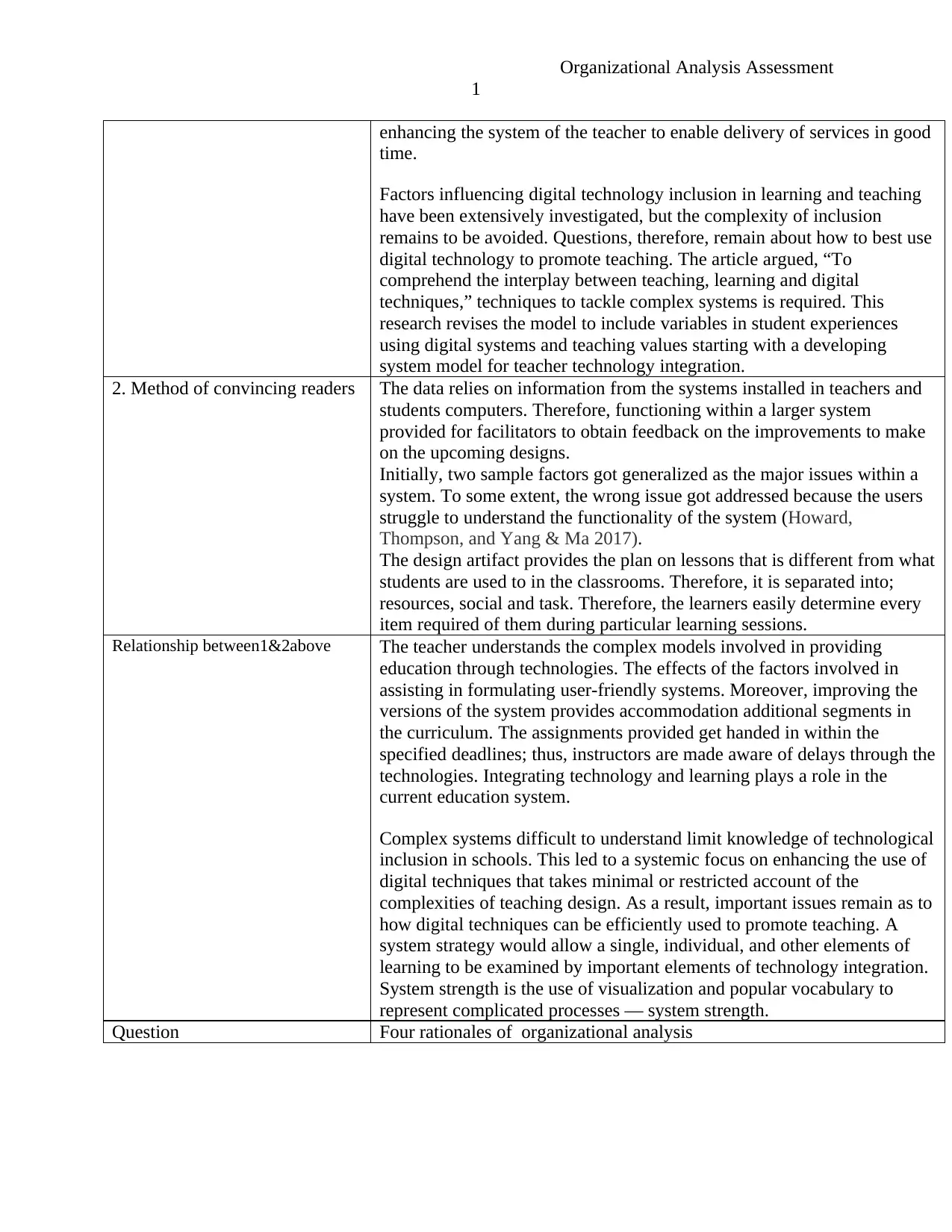
Organizational Analysis Assessment
1
enhancing the system of the teacher to enable delivery of services in good
time.
Factors influencing digital technology inclusion in learning and teaching
have been extensively investigated, but the complexity of inclusion
remains to be avoided. Questions, therefore, remain about how to best use
digital technology to promote teaching. The article argued, “To
comprehend the interplay between teaching, learning and digital
techniques,” techniques to tackle complex systems is required. This
research revises the model to include variables in student experiences
using digital systems and teaching values starting with a developing
system model for teacher technology integration.
2. Method of convincing readers The data relies on information from the systems installed in teachers and
students computers. Therefore, functioning within a larger system
provided for facilitators to obtain feedback on the improvements to make
on the upcoming designs.
Initially, two sample factors got generalized as the major issues within a
system. To some extent, the wrong issue got addressed because the users
struggle to understand the functionality of the system (Howard,
Thompson, and Yang & Ma 2017).
The design artifact provides the plan on lessons that is different from what
students are used to in the classrooms. Therefore, it is separated into;
resources, social and task. Therefore, the learners easily determine every
item required of them during particular learning sessions.
Relationship between1&2above The teacher understands the complex models involved in providing
education through technologies. The effects of the factors involved in
assisting in formulating user-friendly systems. Moreover, improving the
versions of the system provides accommodation additional segments in
the curriculum. The assignments provided get handed in within the
specified deadlines; thus, instructors are made aware of delays through the
technologies. Integrating technology and learning plays a role in the
current education system.
Complex systems difficult to understand limit knowledge of technological
inclusion in schools. This led to a systemic focus on enhancing the use of
digital techniques that takes minimal or restricted account of the
complexities of teaching design. As a result, important issues remain as to
how digital techniques can be efficiently used to promote teaching. A
system strategy would allow a single, individual, and other elements of
learning to be examined by important elements of technology integration.
System strength is the use of visualization and popular vocabulary to
represent complicated processes — system strength.
Question Four rationales of organizational analysis
1
enhancing the system of the teacher to enable delivery of services in good
time.
Factors influencing digital technology inclusion in learning and teaching
have been extensively investigated, but the complexity of inclusion
remains to be avoided. Questions, therefore, remain about how to best use
digital technology to promote teaching. The article argued, “To
comprehend the interplay between teaching, learning and digital
techniques,” techniques to tackle complex systems is required. This
research revises the model to include variables in student experiences
using digital systems and teaching values starting with a developing
system model for teacher technology integration.
2. Method of convincing readers The data relies on information from the systems installed in teachers and
students computers. Therefore, functioning within a larger system
provided for facilitators to obtain feedback on the improvements to make
on the upcoming designs.
Initially, two sample factors got generalized as the major issues within a
system. To some extent, the wrong issue got addressed because the users
struggle to understand the functionality of the system (Howard,
Thompson, and Yang & Ma 2017).
The design artifact provides the plan on lessons that is different from what
students are used to in the classrooms. Therefore, it is separated into;
resources, social and task. Therefore, the learners easily determine every
item required of them during particular learning sessions.
Relationship between1&2above The teacher understands the complex models involved in providing
education through technologies. The effects of the factors involved in
assisting in formulating user-friendly systems. Moreover, improving the
versions of the system provides accommodation additional segments in
the curriculum. The assignments provided get handed in within the
specified deadlines; thus, instructors are made aware of delays through the
technologies. Integrating technology and learning plays a role in the
current education system.
Complex systems difficult to understand limit knowledge of technological
inclusion in schools. This led to a systemic focus on enhancing the use of
digital techniques that takes minimal or restricted account of the
complexities of teaching design. As a result, important issues remain as to
how digital techniques can be efficiently used to promote teaching. A
system strategy would allow a single, individual, and other elements of
learning to be examined by important elements of technology integration.
System strength is the use of visualization and popular vocabulary to
represent complicated processes — system strength.
Question Four rationales of organizational analysis
Paraphrase This Document
Need a fresh take? Get an instant paraphrase of this document with our AI Paraphraser
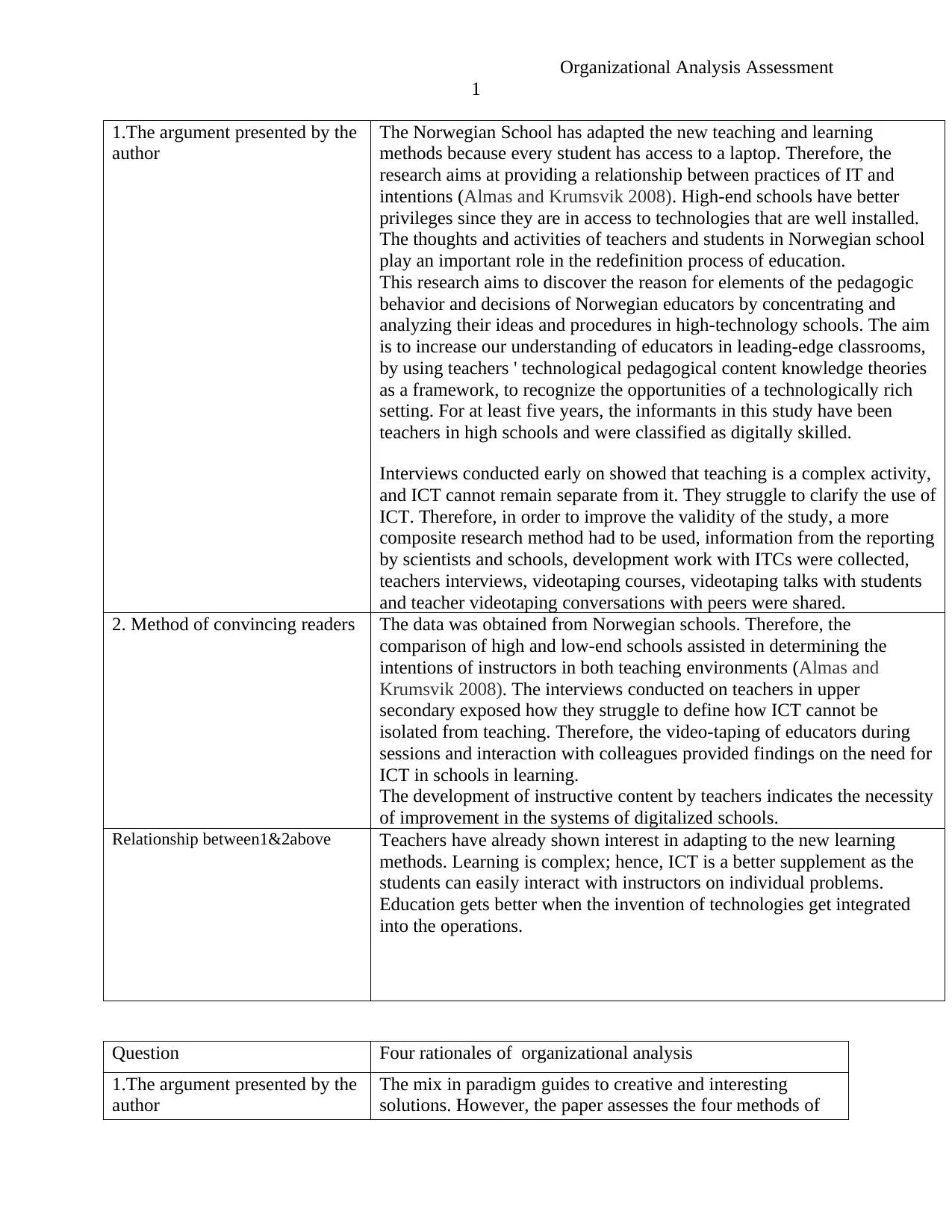
Organizational Analysis Assessment
1
1.The argument presented by the
author
The Norwegian School has adapted the new teaching and learning
methods because every student has access to a laptop. Therefore, the
research aims at providing a relationship between practices of IT and
intentions (Almas and Krumsvik 2008). High-end schools have better
privileges since they are in access to technologies that are well installed.
The thoughts and activities of teachers and students in Norwegian school
play an important role in the redefinition process of education.
This research aims to discover the reason for elements of the pedagogic
behavior and decisions of Norwegian educators by concentrating and
analyzing their ideas and procedures in high-technology schools. The aim
is to increase our understanding of educators in leading-edge classrooms,
by using teachers ' technological pedagogical content knowledge theories
as a framework, to recognize the opportunities of a technologically rich
setting. For at least five years, the informants in this study have been
teachers in high schools and were classified as digitally skilled.
Interviews conducted early on showed that teaching is a complex activity,
and ICT cannot remain separate from it. They struggle to clarify the use of
ICT. Therefore, in order to improve the validity of the study, a more
composite research method had to be used, information from the reporting
by scientists and schools, development work with ITCs were collected,
teachers interviews, videotaping courses, videotaping talks with students
and teacher videotaping conversations with peers were shared.
2. Method of convincing readers The data was obtained from Norwegian schools. Therefore, the
comparison of high and low-end schools assisted in determining the
intentions of instructors in both teaching environments (Almas and
Krumsvik 2008). The interviews conducted on teachers in upper
secondary exposed how they struggle to define how ICT cannot be
isolated from teaching. Therefore, the video-taping of educators during
sessions and interaction with colleagues provided findings on the need for
ICT in schools in learning.
The development of instructive content by teachers indicates the necessity
of improvement in the systems of digitalized schools.
Relationship between1&2above Teachers have already shown interest in adapting to the new learning
methods. Learning is complex; hence, ICT is a better supplement as the
students can easily interact with instructors on individual problems.
Education gets better when the invention of technologies get integrated
into the operations.
Question Four rationales of organizational analysis
1.The argument presented by the
author
The mix in paradigm guides to creative and interesting
solutions. However, the paper assesses the four methods of
1
1.The argument presented by the
author
The Norwegian School has adapted the new teaching and learning
methods because every student has access to a laptop. Therefore, the
research aims at providing a relationship between practices of IT and
intentions (Almas and Krumsvik 2008). High-end schools have better
privileges since they are in access to technologies that are well installed.
The thoughts and activities of teachers and students in Norwegian school
play an important role in the redefinition process of education.
This research aims to discover the reason for elements of the pedagogic
behavior and decisions of Norwegian educators by concentrating and
analyzing their ideas and procedures in high-technology schools. The aim
is to increase our understanding of educators in leading-edge classrooms,
by using teachers ' technological pedagogical content knowledge theories
as a framework, to recognize the opportunities of a technologically rich
setting. For at least five years, the informants in this study have been
teachers in high schools and were classified as digitally skilled.
Interviews conducted early on showed that teaching is a complex activity,
and ICT cannot remain separate from it. They struggle to clarify the use of
ICT. Therefore, in order to improve the validity of the study, a more
composite research method had to be used, information from the reporting
by scientists and schools, development work with ITCs were collected,
teachers interviews, videotaping courses, videotaping talks with students
and teacher videotaping conversations with peers were shared.
2. Method of convincing readers The data was obtained from Norwegian schools. Therefore, the
comparison of high and low-end schools assisted in determining the
intentions of instructors in both teaching environments (Almas and
Krumsvik 2008). The interviews conducted on teachers in upper
secondary exposed how they struggle to define how ICT cannot be
isolated from teaching. Therefore, the video-taping of educators during
sessions and interaction with colleagues provided findings on the need for
ICT in schools in learning.
The development of instructive content by teachers indicates the necessity
of improvement in the systems of digitalized schools.
Relationship between1&2above Teachers have already shown interest in adapting to the new learning
methods. Learning is complex; hence, ICT is a better supplement as the
students can easily interact with instructors on individual problems.
Education gets better when the invention of technologies get integrated
into the operations.
Question Four rationales of organizational analysis
1.The argument presented by the
author
The mix in paradigm guides to creative and interesting
solutions. However, the paper assesses the four methods of
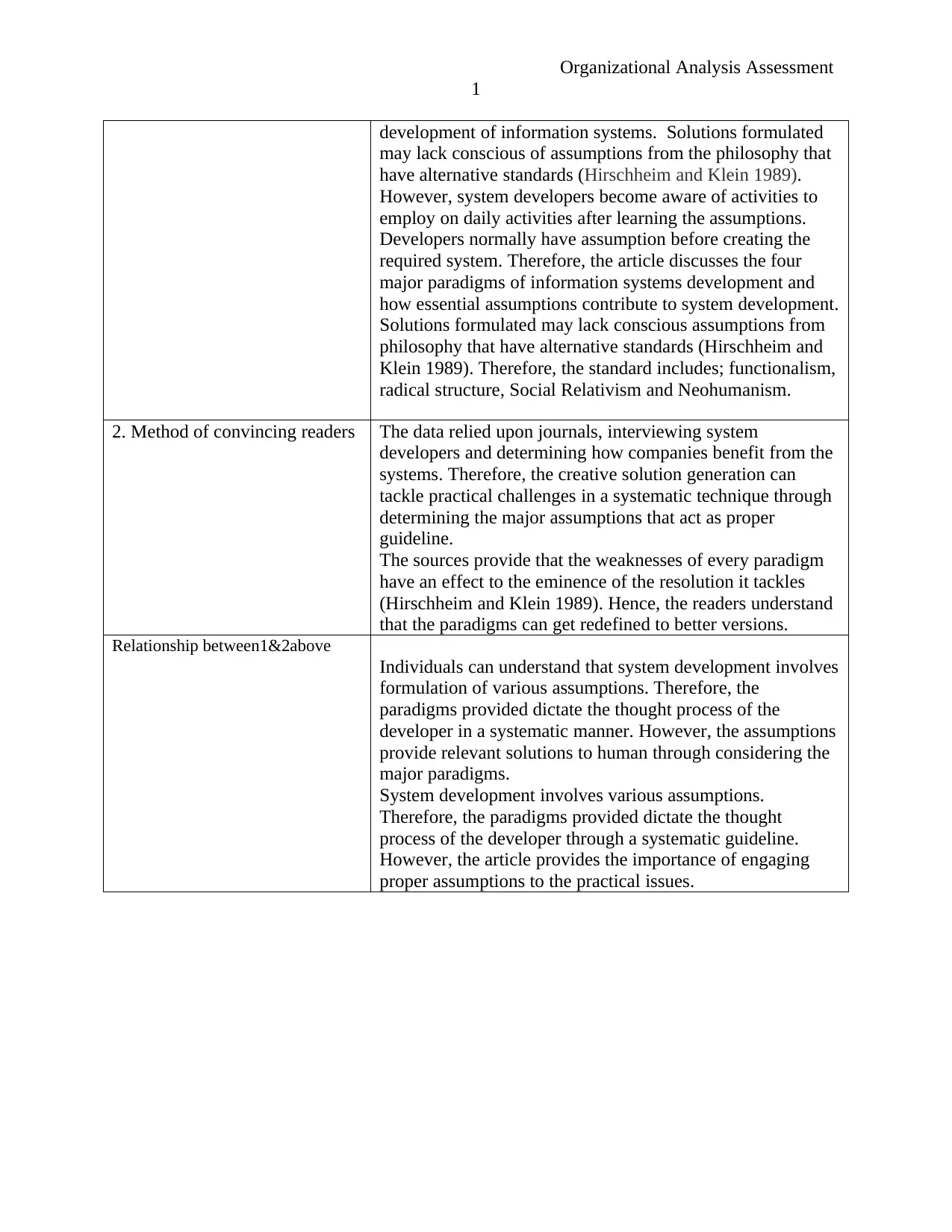
Organizational Analysis Assessment
1
development of information systems. Solutions formulated
may lack conscious of assumptions from the philosophy that
have alternative standards (Hirschheim and Klein 1989).
However, system developers become aware of activities to
employ on daily activities after learning the assumptions.
Developers normally have assumption before creating the
required system. Therefore, the article discusses the four
major paradigms of information systems development and
how essential assumptions contribute to system development.
Solutions formulated may lack conscious assumptions from
philosophy that have alternative standards (Hirschheim and
Klein 1989). Therefore, the standard includes; functionalism,
radical structure, Social Relativism and Neohumanism.
2. Method of convincing readers The data relied upon journals, interviewing system
developers and determining how companies benefit from the
systems. Therefore, the creative solution generation can
tackle practical challenges in a systematic technique through
determining the major assumptions that act as proper
guideline.
The sources provide that the weaknesses of every paradigm
have an effect to the eminence of the resolution it tackles
(Hirschheim and Klein 1989). Hence, the readers understand
that the paradigms can get redefined to better versions.
Relationship between1&2above
Individuals can understand that system development involves
formulation of various assumptions. Therefore, the
paradigms provided dictate the thought process of the
developer in a systematic manner. However, the assumptions
provide relevant solutions to human through considering the
major paradigms.
System development involves various assumptions.
Therefore, the paradigms provided dictate the thought
process of the developer through a systematic guideline.
However, the article provides the importance of engaging
proper assumptions to the practical issues.
1
development of information systems. Solutions formulated
may lack conscious of assumptions from the philosophy that
have alternative standards (Hirschheim and Klein 1989).
However, system developers become aware of activities to
employ on daily activities after learning the assumptions.
Developers normally have assumption before creating the
required system. Therefore, the article discusses the four
major paradigms of information systems development and
how essential assumptions contribute to system development.
Solutions formulated may lack conscious assumptions from
philosophy that have alternative standards (Hirschheim and
Klein 1989). Therefore, the standard includes; functionalism,
radical structure, Social Relativism and Neohumanism.
2. Method of convincing readers The data relied upon journals, interviewing system
developers and determining how companies benefit from the
systems. Therefore, the creative solution generation can
tackle practical challenges in a systematic technique through
determining the major assumptions that act as proper
guideline.
The sources provide that the weaknesses of every paradigm
have an effect to the eminence of the resolution it tackles
(Hirschheim and Klein 1989). Hence, the readers understand
that the paradigms can get redefined to better versions.
Relationship between1&2above
Individuals can understand that system development involves
formulation of various assumptions. Therefore, the
paradigms provided dictate the thought process of the
developer in a systematic manner. However, the assumptions
provide relevant solutions to human through considering the
major paradigms.
System development involves various assumptions.
Therefore, the paradigms provided dictate the thought
process of the developer through a systematic guideline.
However, the article provides the importance of engaging
proper assumptions to the practical issues.
⊘ This is a preview!⊘
Do you want full access?
Subscribe today to unlock all pages.

Trusted by 1+ million students worldwide
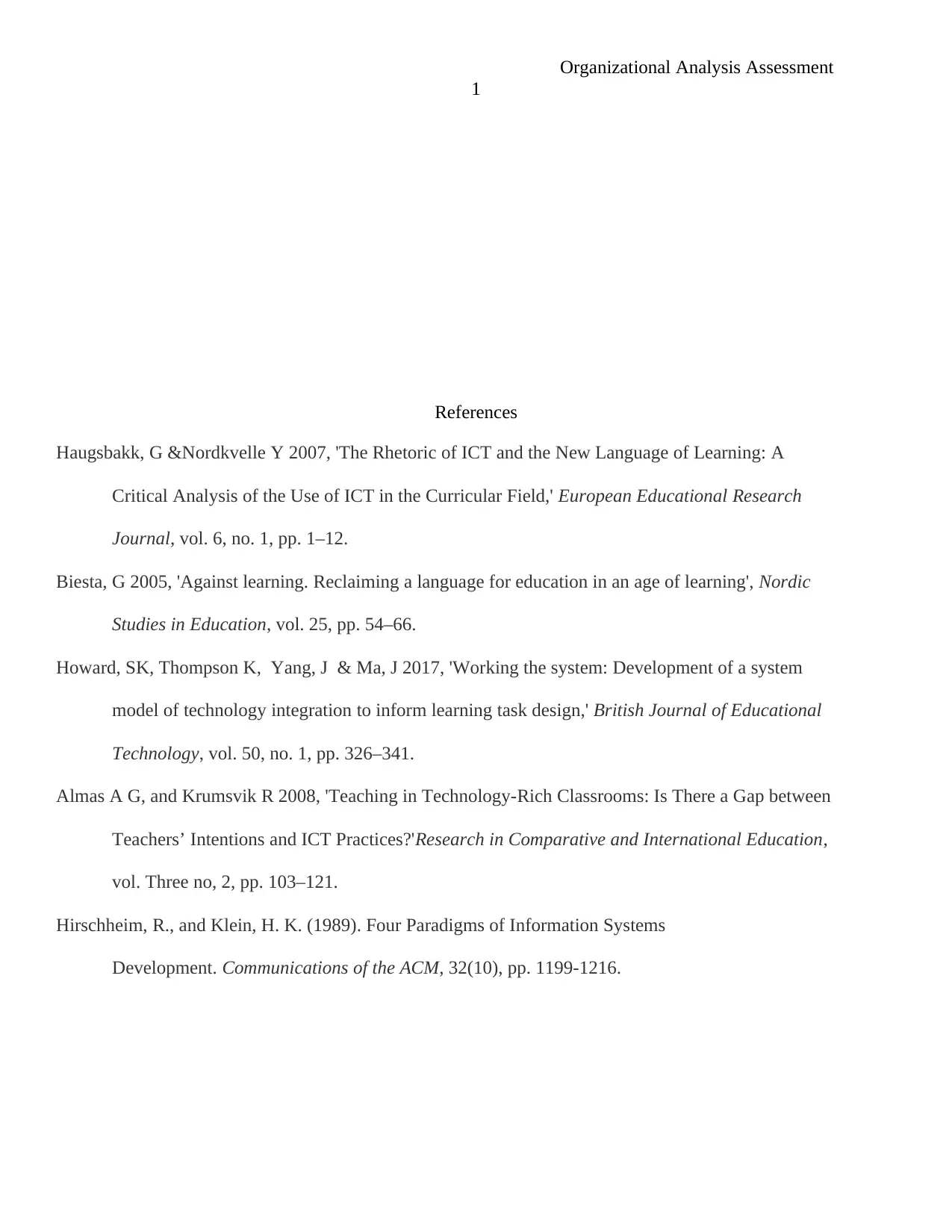
Organizational Analysis Assessment
1
References
Haugsbakk, G &Nordkvelle Y 2007, 'The Rhetoric of ICT and the New Language of Learning: A
Critical Analysis of the Use of ICT in the Curricular Field,' European Educational Research
Journal, vol. 6, no. 1, pp. 1–12.
Biesta, G 2005, 'Against learning. Reclaiming a language for education in an age of learning', Nordic
Studies in Education, vol. 25, pp. 54–66.
Howard, SK, Thompson K, Yang, J & Ma, J 2017, 'Working the system: Development of a system
model of technology integration to inform learning task design,' British Journal of Educational
Technology, vol. 50, no. 1, pp. 326–341.
Almas A G, and Krumsvik R 2008, 'Teaching in Technology-Rich Classrooms: Is There a Gap between
Teachers’ Intentions and ICT Practices?'Research in Comparative and International Education,
vol. Three no, 2, pp. 103–121.
Hirschheim, R., and Klein, H. K. (1989). Four Paradigms of Information Systems
Development. Communications of the ACM, 32(10), pp. 1199-1216.
1
References
Haugsbakk, G &Nordkvelle Y 2007, 'The Rhetoric of ICT and the New Language of Learning: A
Critical Analysis of the Use of ICT in the Curricular Field,' European Educational Research
Journal, vol. 6, no. 1, pp. 1–12.
Biesta, G 2005, 'Against learning. Reclaiming a language for education in an age of learning', Nordic
Studies in Education, vol. 25, pp. 54–66.
Howard, SK, Thompson K, Yang, J & Ma, J 2017, 'Working the system: Development of a system
model of technology integration to inform learning task design,' British Journal of Educational
Technology, vol. 50, no. 1, pp. 326–341.
Almas A G, and Krumsvik R 2008, 'Teaching in Technology-Rich Classrooms: Is There a Gap between
Teachers’ Intentions and ICT Practices?'Research in Comparative and International Education,
vol. Three no, 2, pp. 103–121.
Hirschheim, R., and Klein, H. K. (1989). Four Paradigms of Information Systems
Development. Communications of the ACM, 32(10), pp. 1199-1216.
1 out of 7
Related Documents
Your All-in-One AI-Powered Toolkit for Academic Success.
+13062052269
info@desklib.com
Available 24*7 on WhatsApp / Email
![[object Object]](/_next/static/media/star-bottom.7253800d.svg)
Unlock your academic potential
Copyright © 2020–2025 A2Z Services. All Rights Reserved. Developed and managed by ZUCOL.





